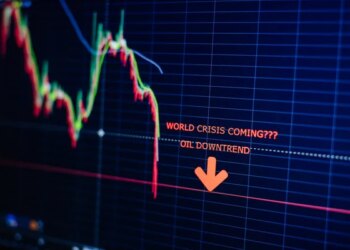In the world of investing, we are conditioned to focus on visible threats: volatile market swings, corporate bankruptcies, and geopolitical instability. Yet, the most relentless and corrosive force acting against your wealth is often the one that works in silence. Inflation, the “silent thief,” is the steady, upward creep in the prices of goods and services that methodically erodes the purchasing power of your money. A positive return in your brokerage account can feel like a victory, but if it doesn’t outpace inflation, you are, in reality, running on a treadmill, losing ground with every step.
Understanding the profound impact of inflation on your portfolio is not an academic exercise; it is a fundamental requirement for long-term financial survival and growth. Every dollar you save and invest is in a constant race against its own declining value. This isn’t about simply preserving your capital; it’s about ensuring your future self can afford the same, or a better, lifestyle than you have today. A 4% gain in a 5% inflationary environment is, by definition, a 1% loss of real-world buying power.
This comprehensive guide will dissect the intricate ways inflation wages a multi-front war on your investments. We will explore how each major asset class—from the cash in your savings account to your stocks, bonds, and real estate holdings—reacts under inflationary pressure. More importantly, we will provide a strategic blueprint of actionable, time-tested strategies to not only defend your portfolio but to position it to thrive when the cost of living rises.
The Core Concept: Understanding Real vs. Nominal Returns
Before delving into specific asset classes, it’s crucial to grasp the single most important concept in this discussion: the difference between nominal and real returns. This distinction is the lens through which all investment performance must be viewed in an inflationary world.
- Nominal Return: This is the straightforward percentage gain or loss on your investment. If you invest $1,000 and it grows to $1,080 in a year, your nominal return is 8%. It’s the number you see on your account statement.
- Real Return: This is the true measure of your investment’s success. It is your nominal return minus the rate of inflation. Using the example above, if inflation for that same year was 3%, your real return would be 5% (8% – 3%). However, if inflation was a staggering 10%, your impressive 8% nominal gain would actually be a -2% real return. You have more dollars, but those dollars buy less than what you started with.
Every investment decision should be aimed at achieving a positive real return. A portfolio that fails to do so is not growing; it is simply shrinking at a slower rate.
How Inflation Impacts Each Asset Class
Inflation is not a monolithic force; it affects different parts of your portfolio in vastly different ways. Understanding these nuances is the first step toward building a resilient investment strategy.
A. Cash and Cash Equivalents: The Guaranteed Loser
The most direct and brutal victim of inflation is cash. Money held in savings accounts, checking accounts, certificates of deposit (CDs), and money market funds is on the front line of purchasing power erosion. The interest rates offered on these accounts almost never keep pace with moderate to high inflation.
While it’s essential to have an emergency fund in liquid cash, holding excessive amounts is a surefire way to lose wealth over time. Every day, each dollar held in cash buys a little bit less than the day before. The safety of cash is an illusion when measured in terms of what it can actually provide for you in the future.
B. Bonds (Fixed-Income): A Tale of Two Headaches
Bonds have traditionally been seen as a stabilizing force in a portfolio, providing predictable income. However, in an inflationary environment, they face a significant double-threat.
- Purchasing Power Risk: The primary appeal of a bond is its fixed coupon payment. If you buy a bond that pays a 4% coupon, you receive that same dollar amount every year until maturity. When inflation rises, that fixed payment buys fewer goods and services each year, diminishing the real return of your investment.
- Interest Rate Risk: To combat inflation, central banks (like the Federal Reserve) typically raise interest rates. This has a direct and inverse impact on the price of existing bonds. Why would an investor buy your old bond paying a 4% coupon when they can buy a newly issued bond of similar quality paying 6%? To sell your old bond, you would have to lower its price to a point where its yield becomes competitive with new bonds. The longer the bond’s duration (its maturity date), the more sensitive its price is to interest rate changes.
C. Stocks (Equities): A Complex and Varied Battleground
The effect of inflation on the stock market is far more nuanced. It creates both winners and losers, making careful selection paramount.
- The Headwinds: Inflation can harm many businesses by increasing their costs. The price of raw materials, inventory, and labor all go up, which can squeeze profit margins if the company cannot pass those costs onto its customers. Furthermore, rising interest rates make it more expensive for companies to borrow money for expansion, and it also makes future earnings less valuable when discounted back to the present day. High inflation can also dampen consumer demand as households tighten their belts, hurting companies that sell discretionary goods.
- The Tailwinds: Not all companies suffer. The key differentiator is pricing power. Businesses with strong brands, essential products, or dominant market positions can raise their prices to offset their rising costs, protecting their profitability. Think of companies in sectors like consumer staples (food, beverages, household goods), healthcare (pharmaceuticals, medical devices), and energy. These companies often sell things people need regardless of the economic climate, giving them the power to pass inflation on to the end consumer. Additionally, companies that own significant tangible assets (factories, land, resources) will see the value of those assets appreciate on their balance sheets.
D. Real Estate: A Classic Inflation Hedge

Real estate, both physical property and Real Estate Investment Trusts (REITs), has long been considered one of the most reliable hedges against inflation for several key reasons.
- Appreciating Asset Values: The value of land and buildings tends to rise with, or even exceed, the rate of inflation. The cost to build a new home goes up due to labor and material costs, which in turn pulls up the value of existing properties.
- Rising Rental Income: For investment properties, landlords can increase rents over time to match the rising cost of living. This allows the income stream from the property to keep pace with inflation.
- Debt Erosion: This is a powerful, often overlooked benefit. If you have a fixed-rate mortgage on a property, your payment is static. As inflation rises over the years, you are paying back that loan with dollars that are worth less and less, effectively reducing the real cost of your debt.
E. Commodities: A Direct Beneficiary
Commodities are the raw materials that fuel the economy—think oil, natural gas, industrial metals like copper, precious metals like gold, and agricultural products. They have a direct and positive correlation with inflation.
Often, rising commodity prices are a primary cause of inflation itself. When the cost of energy and raw materials goes up, the price of finished goods follows. Therefore, having a portion of your portfolio invested in a broad basket of commodities, typically through an ETF or mutual fund, can act as a very direct and effective hedge, as the value of these assets will likely rise during an inflationary period.
Strategic Blueprint: How to Fortify Your Portfolio

Knowing how each asset reacts is one thing; building a durable, inflation-resistant portfolio is another. This requires a proactive, multi-pronged strategy.
A. Prioritize Real Assets and Equities: Your core defense should be a diversified portfolio of assets that have the potential to grow faster than inflation. This means a healthy allocation to stocks, particularly those of companies with strong balance sheets and pricing power. It also includes allocations to real estate (through REITs for liquidity or direct ownership) and commodities.
B. Incorporate Inflation-Protected Bonds: To mitigate the risk in the fixed-income portion of your portfolio, consider specific types of bonds designed to combat inflation. Treasury Inflation-Protected Securities (TIPS) are government bonds whose principal value adjusts upward with the Consumer Price Index (CPI), ensuring your investment keeps pace with inflation. The interest payments, while small, are also based on this adjusted principal.
C. Shorten Your Bond Duration: If you hold traditional bonds, favor those with shorter maturities. Short-term bonds are less sensitive to the interest rate hikes that typically accompany inflation, meaning their prices will not fall as drastically as those of long-term bonds.
D. Focus on Value and Dividends: In an inflationary environment, speculative growth stocks whose valuations are based on distant future earnings can be hit hard by rising interest rates. Consider shifting focus to value stocks—profitable, established companies that trade at reasonable valuations and often pay a reliable dividend. A growing dividend stream can be a powerful source of income that helps offset the effects of inflation.
E. Re-evaluate and Rebalance Regularly: An inflationary environment is dynamic. It’s crucial to review your portfolio at least annually to ensure your asset allocation is still aligned with your goals. Rebalancing—selling some of your winners and buying more of your underperforming assets—forces you to buy low and sell high and ensures your portfolio remains diversified and prepared for changing economic conditions.
In conclusion, inflation is an unavoidable feature of the economic landscape. It is a formidable opponent that cannot be ignored. However, by understanding its mechanisms and by building a diversified portfolio that includes a strategic mix of equities with pricing power, real assets like real estate, commodities, and inflation-protected securities, you can transform this threat into an opportunity. A well-constructed portfolio doesn’t just survive inflation; it leverages the underlying economic forces to continue generating positive real returns, ensuring your wealth grows not just in name, but in true purchasing power.












